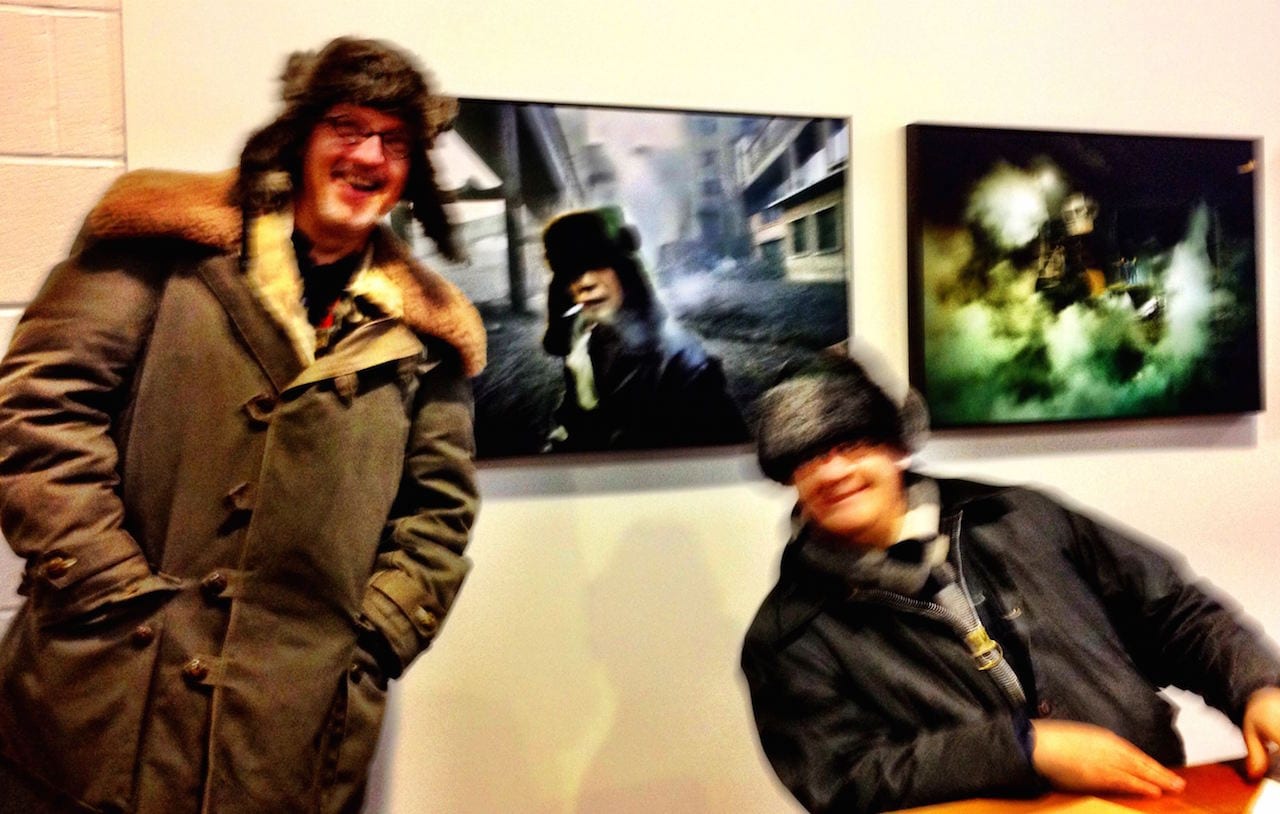Peter James was an instrumental figure in British photography, establishing an outstanding collection of photography at the Library of Birmingham over his 26-year career at the institution, and researching and curating exhibitions at the V&A, National Portrait Gallery, Somerset House, Birmingham Museum and Art Gallery, Ikon Galley, the Library of Birmingham, and many more. He was also a modest and affable man, universally known as Pete and as at home over a curry as in a lecture hall delivering an academic paper.
As Hilary Roberts, research curator at the Imperial War Museum, put it in a tribute on James’ Facebook page: “Pete has been a wonderful friend and exceptional colleague for more years than I can remember. His contribution to the world of photography cannot be overstated. It was a privilege to work with him and I will miss him more than I can say.”
“I’m trying to write something about Pete James but I realise words fail me,” added photographer Brian Griffin, who worked with James many times, including on Reference Works – the inaugural show at the Library of Birmingham after it reopened in 2013 in a state-of-the-art new building, which included an exhibition space.
Born in 1958, James found his way into photography almost by accident, first realising he had an interest in images in the late 1970s. “I was working at the Kodak plant in Harrow,” he told Genesis Imaging back in 2013. “Used to visit the Kodak Museum a lot during breaks”.
He went on to take a BA in Humanities, Ceramics and Art History at the Polytechnic of Wales from 1984-1987, and to study the History of Photography, and Art & Design, at Birmingham City University from 1986-89. “It was Birmingham Polytechnic back in the day,” James noted in his LinkedIn profile, with typically dry and irreverent wit.
He became Curator of Photography Collections at the Library of Birmingham in January 1989 and stayed until he was made redundant – along with the rest of the photography team – in October 2015. Over those 26 years and 10 months he built up an unrivalled archive of British photography, one of the UK’s National Collections of Photography and including over three million images, ranging from historical photographs by Sir Benjamin Stone to entire archives of work by renowned figures such as Daniel Meadows, Martin Parr, Brian Griffin, John Myers, Anna Fox, Vanley Burke, and Val Williams.
“So sorry to hear this news today,” wrote Meadows on James’ Facebook page. “RIP Pete James. Pete was a very important character in my career. For a decade he nursed me through the process of getting my archive into the kind of shape that would give other people a chance to see its worth. And in the process we became very good friends. I’ll miss him very, very much. A generous, thoughtful and funny man.”
“In 2009 I had two exhibitions in Arles, The Water People and St. Pancras, over 100 framed pieces and after the festival they were going to return to me,” Brian Griffin tells BJP. “That was storage that I just could not financially afford, so I said to the then-festival director Francois Hebel ‘Please throw them in the river Rhone don’t return them!”. Pete quickly interjected and said ‘I’ll have them’ and this he has repeatedly done – Birmingham Library has tonnes in weight of my past framed exhibited images because of Pete.”
“The new Library of Birmingham opened in September 2013 with a festival which included three days of Self Portraits,” adds Brian Homer. “Prior to the opening Pete had commissioned me, Timm Sonnenschein and Graham Peet (then of The Public) to create 1000 Self Portraits for the opening and these were displayed on the huge screens in the lending area and can often still be seen.
“We worked closely with Pete in the run up to the opening including consultation with the development team to get the screen specification sorted. Pete was a delight to work with – straightforward, caring and he negotiated the inevitable bureaucracy with a wry smile but a positive attitude.
“But before this commission he always had a keen interest in the Handsworth Self Portrait that I had done in 1979 with Derek Bishton and John Reardon. When Ten.8 photography magazine closed in the early 1990s, holding a range of exhibition material, he brokered the joint purchase of the original HSP prints by the Birmingham Central Library and Birmingham Museum and Art Gallery.
“Pete deserves enormous credit for this resurgence of Self Portrait work and it’s is so sad that we will not be able to work together as planned in Multistory’s Blast Festival in 2019 – marking 40 years since Handsworth Self Portrait. This is just a small part of his impact on photography in the UK and there are many other who will have similar stories to tell. His presence on the photography scene will be greatly missed.”

Tragically, just two years after opening the Library of Birmingham’s new building, the city council announced swingeing budget cuts, making 100 of the library’s 188 staff redundant, including the entire photography department, and slashing funding by £1.5m over the next year. A petition against the closure was set up at the time by a group of photographers including Paul Hill, who had been the first living photographer to sell his archive to the institution.
“I first met Pete in 1990s when he wanted my opinion on his plans to combine the various photographic holdings in what was Birmingham Central Library into one ‘proper’ collection of photographs. Despite some internal opposition he achieved this ambition and later it became an accredited ‘national’ collection,” Hill tells BJP.
“He acquired some of my prints in 2000 and later expressed a desire to acquire my archive as it related to my workshop and study centre, The Photographers’ Place in Derbyshire, and other professional material I wanted to find a home for. In 2003 Pete embarked on a tortuous journey in order to find funds for the purchase. It was the first time a living photographer’s archive had been acquired by such an institution in the UK. Eventually he accessed enough funding to make the acquisition in 2004.
“This changed both our lives as it was a useful template for several successful acquisitions of photographers work that included the archives of Daniel Meadows, Brian Griffin, Vanley Burke, John Blakemore, John Myers, and Val Williams.
“I was delighted that he was able to go ahead with the acquisition because it reflected an important era for British photography and I come from the Midlands. It also helped me financially as most of my life In have been a freelance, so I will always be grateful to Pete on both counts. Our paths crossed on many occasions subsequently and we had several plans afoot before the disastrous closing down of his department in 2015.”
Fortunately James had worked on many other initiatives over the years, including chairing the Committee of National Photography Collections, co-founding the Photography Collections Network, co-founding and co-directing GRAIN: the photographic hub and network for the West Midlands in 2012, supporting projects such as Ten:8, Arts Council West Midlands, Rhubarb Rhubarb, and FORMAT Festival, lecturing and working with many academic institutions, writing books, and curating exhibitions.

He was a speaker at the Fast Forward: Women in Photography conference at Tate in November 2015, and more recently worked with Mat Collishaw on his exhibition Thresholds which used VT Technology to re-stage one of the earliest exhibitions of photography – William Henry Fox Talbot’s presentation of photographic prints at King Edward’s School, Birmingham. Launched at Somerset House from 18 May to 11 Jun 2017, Thresholds then toured to Birmingham Museum and Art Gallery, then the Fox Talbot Museum in Lacock, Wiltshire, and is now on show at the National Science and Media Museum Bradford until 07 May.
Latterly James suffered ill health for a number of years – he felt, as Brian Griffin puts it, “that he had one foot on a banana skin”. Even so he remained committed to photography, looking forward to working on Multistory’s Blast Festival in 2019, and messaging photographers about their work right up until the end. “Only last Wednesday I was discussing with him by email regarding transferring some of my framed images to the collection from the old library,” says Griffin. “Little did I realise he was lying in a hospital bed seriously ill.”
James went into hospital two weeks ago and initial hopes that he’d soon return home quickly faded. He died on 11 March, surrounded by close family; he leaves a wife, Heather, and two children, Evan and Nola.
David Ellison, photographer and senior lecturer in commercial photography at the Arts University Bournemouth, adds:
“I first came into contact with Pete James whilst photographic assistant to Brian Griffin, working on a commission to commemorate the building of the new Library of Birmingham. Like Brian Griffin steeped in the photographic arts, he acted almost as a mentor, drawing on his vast knowledge and insights to offer advice that has now been firmly stored and incorporated into my own photographic practice.
“On pre-shoot visits to the old Birmingham Central Library, Pete showed us the photography archive he had curated, an impressive collection of images that were part of the exciting removal challenge to the new library, offering state of the art facilities. Pete and his team were wholeheartedly invested in the project to collect photography, new and old, both from emerging talent and established names. He was rightly proud of his immense achievements.
“The question of who is supporting new photography today has to be raised – the answer, in the main part, was Pete James until his sad redundancy. When Pete lost his job, all our hopes of an exciting new future for photography vanished.
“Aside from Pete’s professional involvements and achievements, he was an immensely likeable and genuine person. I remember him gifting me books that he helped to publish. We would often go for a meal after long days on set in Birmingham. Hearing him talk about photography with the production crew over a curry (and, often, too many drinks!) was something that really inspired me and made me feel involved and part of larger organisation. He knew I had potential and valued my input as a young photographer.
“He was a talented academic too. He shared the stage with my wife Ailbhe Greaney [photographer, and lecturer in photography/course director MFA Photography Belfast School of Art] and spoke as part of the Fast Forward: Women in Photography conference at Tate Modern in 2015. Seeing him at the conference, he gave me a warm embrace. This was the character of the man – a giant in British photography who will never be forgotten.”

